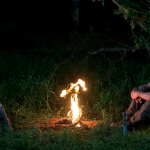Faith in the better story is an important signal, but is it wondrous and hopeful enough?
Ang Lee’s ambitious — and, on the whole, successful — film adaptation of Yann Martel’s acclaimed novel Life of Pi begins with a rather audacious claim: we’re going to be told a story that “will make [us] believe in God.” There has been much conversation within religious circles regarding the film’s somewhat controversial religious themes. But before approaching those themes, it’s helpful to consider this opening assertion in its proper context: The line is confidently uttered by the story’s main character, Piscine “Pi” Patel, and he is making the claim in conversation with a fiction writer.
Notably, this context is emphasized differently in the novel. While the film features a generic writer, the novel situates the telling of the story within an authorial note designed as an important introduction to the novel’s metafictive themes. In a framing choice which emphasizes the blurry lines between “reality”, “fiction”, and “truth” with an intrusive narrator, it’s Martel himself who discovers Pi and listens to his story. Martel is recounting a story about Pi that Pi himself has conveyed to him. In the film, it’s never suggested that the writer is Martel, which makes sense for the film’s purposes. Instead, this metafictive element is highlighted by the recurrence of the context: We, the viewers, are consistently made aware of Pi’s life as a story which is being told. With this context in mind, the opening assertion is uttered with a particular emphasis which might be communicated this way: stories make us believe in God.
Life of Pi is about the human awareness of, and desire for, divinely instituted significance — and how the fictive and religious imaginations are signals of this mysterious, baseline meaningfulness.
So what’s the story? Following the book, the film is divided into three sections. The first is an entry into Pi’s memories of childhood. We learn that Pi grew up around animals because his father owned a zoo in Pondicherry. Being raised in this environment has given the Indian boy some insight into animal behavior. The other important detail from Pi’s background is that he was raised a Hindu but, as a teenager, was also introduced to Christianity and Islam. Out of a seemingly earnest, but somewhat ignorant desire to love God, he decides to “follow” all three religions by drawing upon each tradition for an amalgamation of a growing understanding of “God”. His faith is tested in the story’s second section when, after his family decides to move with their animals to Canada by crossing the ocean, Pi survives a shipwreck. With his family presumed dead, Pi is stuck on a life boat with a Bengal tiger (along with a hyena, a zebra, and an orangutan). I won’t give away the story’s third section; suffice it to say that we’ve already established that elderly Pi is conveying the story, one which quickly evolves into a survival adventure in the middle of the Pacific.
If Life of Pi works on a metafictive level, what of the survival tale as a genre? Commonly, this type of adventure involves an individual or small group coming upon circumstances in which they must struggle to stay alive. The circumstances often result from an incident which separates them from established human societies. The dire circumstances usually involve a scenario in which the survivors must make due with a discovered “survival kit” containing the barest makeshift tools necessary to fight for life. Given the prolonged state of desperation that the survivors inhabit, they usually discover what they’re made of in terms of resourcefulness. Most importantly, though, the survivalist tale often presses the survivors to reflect on the essential elements of their aliveness, i.e., that which gives being worth or animates human existence. Stripped of distractions, we get introspective. When the survivors are in moments of greatest desperation — when their necessary self-reliance proves inadequate — they often, seemingly naturally, turn to God, their fullest resource.
Taken together, Life of Pi‘s various themes seem to suggest a longing for human significance couched in vaguely religious language. It’s a contemplative tale rooted in questions with room for open-ended interpretation. More specifically, Lee’s film — as an extension of Martel’s novel — suggests that our difficult, often tragic lives matter in a way that cold “facts” can’t totally explain. You might characterize the story as a “desperate” (survivalist) attempt to re-enchant a supposedly disenchanted modern world. Interestingly, in an interview with PBS, Martel says that he wrote his novel during a time when he felt lost: “I was sort of looking for a story, not only with a small ‘s’ but sort of with a capital ‘S’ — something that would direct my life.” Martel’s existential plight seems to have been Pi’s shipwrecked plight: lonely and directionless. Having “faith” in this particular context has a less specific range; its content is the simple belief that our lives — suffering included — are filled with meaning, purpose, and wonder. Which is to say, in Life of Pi, the religious and literary imaginations merely function as signals of the truth of significance itself, a “better Story” compared to a disenchanted, cold rationalism because there is more to humanity and existence than meets the eye.
If I’m right about the function that the major religions play in Life of Pi, then it’s also an implicit answer to the question of whether or not Martel’s story is about religious pluralism. While the film and book certainly have one-liners which suggest a measured affirmation of religious pluralism, it’s not really the focal point of the story. Rather than championing pluralism, Life of Pi’s more explicit aim is to highlight humanity’s “religious nature” as an anthropological signal giving illumination to The Way Things Are. Which is to say: we human beings are inevitably constituted by faith, worship, devotion, and the desire for love, home, and reconciliation. The great religions — in this line of thought more revelatory of humanity’s religious nature than of their specific objects of faith — are a collective signal that the better story we desire is evidence of an existing Best Story, even if we can’t be sure of its more specific content.
The other signal of the better story of humanity’s significance is the fictive imagination. Life of Pi suggests that conveying stories like that of Pi’s life is a way of conveying truth which is just as true as the plain facts. Our love of literature — and artistic narratives, in particular — derives from stories’ import as an expression of the narrative shape of human existence. We can relate to the survival tale, to the desperation for aliveness, to the difficulty of dealing with suffering, and to the quest for meaning. An important emphasis in the film, even if it leaves out these specific lines from the book, is that the better story is not a “flat story.” The flat story is the one with “dry, yeastless factuality.” Stories enliven facts because they embody facts. Stories give facts their significance, in part, by supplying a context which functions as a field of depth. In this light, Lee’s captivating three-dimensional visual approach takes on a formal complementary role, because 3D conveys a fictional pictorial depth, or, an added dimension of visual aliveness.
Insofar as Life of Pi suggests that truth is not merely constituted by blunt, empirical factuality, but also involves qualitative distinctions which press us to wonder at the Good, Lee’s film is often delightful.
The problem with Life of Pi, though, is not so much that Pi embraces pluralism properly speaking (he doesn’t), but that he chooses from religions in accordance with his own preferences. He prays to each of the gods and prophets, he takes each as his own nominally, but he also resists each faith in any dogmatic sense. Instead, he chooses common elements from each tradition which he thinks make for a better story. His dogma is ultimately his preference–that which, to the best of his discernment, is qualitatively better. For Pi, then, the specific distinctiveness of each religion collapses and, ironically, flattens out in their collective function as a signal to some unnamed Better Story. In his honest pursuit of a qualitatively “better” story, Pi’s Story has some specific, even truthful, religious content: For instance, that “no man is an island,” and if one tries to be, he or she will be eaten alive. Or that “God” is Someone to be submitted to, even in the midst of trials. Or that even when that “God” seems to us indifferent or not there, “He” is watching. And there’s no denying that each of the major religions have truths about them.
But the problem, to try to put it more starkly, is that the locus of authority for these anthropological “signals” — specifically, religious and literary significance — resides with Pi’s preference. So he may have met Christ and even enjoyed His presence, but he also seems to have overlooked Christ’s claim to be “the way, the truth, and the life,” and that “no one comes to the Father but by me.” To be clear, I’m not advocating that the story has to be explicitly or identifiably Christian. Rather, I’m suggesting that lumping together aspects of specific religious traditions in accordance with humanity’s preferential sense of the Good ironically limits the potentiality of our knowing God and His Story. There’s a subtle implication that too much dogma means that we have to submit to an authority higher than our preference, and thus run the risk of missing the better story. But what if our sense of the better story isn’t initially or consistently or persistently trustworthy? And what if the dogma of a faith tradition has inbuilt acknowledgement of vast mystery?
What if the story we narrate for ourselves–the one we prefer–isn’t, at bottom, true, but a deceptive figment of our imagination? Is not cold, imaginative comfort as chilly as the cold facts?
Ultimately, the best question we can ask ourselves within the film’s frame of reference is “which story do you prefer?” It’s not meant as a wholly relativistic line and it’s a mistake to conceive of it as such; that we prefer (or collectively know we ought to prefer) the better story is itself a signal that the better story is the True Story. But our desire for the better story, in itself (unaccompanied by an authoritative, trustworthy revelation), is a discomforting, untrustworthy, and unspecific signifier. Tolkien suggested that the truth of our myths pointed to the Truth of Christianity qua Myth. Think of Life of Pi as an inverted “fairy-story” which makes the Incarnated Myth into a mere myth that points to a dry, yeastless Myth.
Besides, if you’re asking, I have faith (constituted by knowing trust and growing preference) that the better story is the eternal triune God who creates us in the significance of His image, who reveals himself in human flesh in human history, whose love leads Him to lay down His life to conquer death for us, who calls us to a dogmatic graciousness, and who inaugurates a narrative of resurrection which makes all things new. It’s within this Story that Pi’s wonderful, spellbinding story of survival makes sense and gains significance.
Illustration courtesy of Seth T. Hahne. Check out his graphic novel and comic review site, Good Ok Bad.












